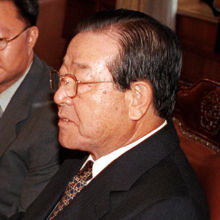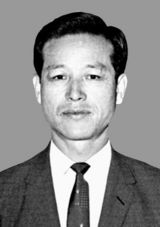Kim Jong-pil facts for kids
Quick facts for kids
Kim Jong-pil
|
|
|---|---|
| 김종필 | |

Kim in 1999
|
|
| 9th Prime Minister of South Korea | |
| In office June 4, 1971 – December 18, 1975 |
|
| President | Park Chung-hee |
| Preceded by | Baek Du-jin |
| Succeeded by | Choi Kyu-hah |
| In office March 3, 1998 – January 12, 2000 |
|
| President | Kim Dae-jung |
| Preceded by | Goh Kun |
| Succeeded by | Park Tae-joon |
| Personal details | |
| Born | January 7, 1926 Fuyo-gun, Chūseinan-dō, Korea (today Buyeo County, South Chungcheong Province, South Korea) |
| Died | June 23, 2018 (aged 92) Seoul, South Korea |
| Political party | Liberty Korea Party |
| Other political affiliations |
|
| Spouse |
Park Young-ok
(m. 1951; died 2015) |
| Children | 2 |
| Alma mater | Korean Military Academy |
| Nickname | JP |
| Military service | |
| Allegiance | |
| Branch/service | |
| Years of service | 1949–1961 |
| Rank | Brigadier General |
| Korean name | |
| Hangul | |
| Hanja | |
| Revised Romanization | Gim Jong-pil |
| McCune–Reischauer | Kim Chongp'il |
| Art name | |
| Hangul | |
| Hanja | |
| Revised Romanization | Unjeong |
| McCune–Reischauer | Unjŏng |
Kim Jong-pil (Korean: 김종필; Hanja: 金鍾泌; January 7, 1926 – June 23, 2018), often called JP, was a very important South Korean politician. He helped create and was the first leader of the Korean Central Intelligence Agency (KCIA). This agency is now called the National Intelligence Service.
He served as Prime Minister two times. His first term was from 1971 to 1975, when Park Chung-hee was president. His second term was from 1998 to 2000, during the presidency of Kim Dae-jung. Kim Jong-pil was also a member of the National Assembly nine times.
Contents
Early Life and Military Service
Kim Jong-pil was born in Buyeo County, which is in South Chungcheong Province. He went to the Korea Military Academy (KMA) and graduated in 1949.
He also studied in the United States for a short time. During the Korean War, he worked as an intelligence officer for the South Korean Army. He later retired from the military as a brigadier general.
Political Journey
After a big protest by citizens and students in 1960, Kim Jong-pil helped plan the May 16 coup in 1961. This event was led by Major General Park Chung-hee. Kim Jong-pil held many important jobs during Park Chung-hee's time as president.
In 1965, he played a key role in setting up official friendly relations with Japan. This was important because Japan had ruled Korea before. The money received from Japan helped South Korea's economy grow a lot. This growth helped create the "Miracle on the Han River," which means South Korea became much richer very quickly.
In 1963, he started the Democratic Republican Party. This party helped President Park Chung-hee stay in power for a long time. Kim Jong-pil was Prime Minister for the first time from 1971 to 1975. He became Prime Minister again from 1998 to 2000, during Kim Dae-jung's presidency.
In 1987, Kim Jong-pil started a new political party called the New Democratic Republican Party. He ran for president but did not win. However, his party did win 35 seats in the National Assembly in 1988.
In 1990, his party joined with two other big parties to form the Democratic Liberal Party (DLP). Kim Jong-pil became a top leader in this new party. This party's candidate, Kim Young-sam, later won the presidential election in 1992.
Kim Jong-pil was known for being very good at forming alliances with other politicians. Even when his popularity went down, he found ways to become strong in politics again. For example, in 1997, he made a deal with Kim Dae-jung. This deal allowed him to choose many government officials and become Prime Minister for the second time in 1998.
In 2004, Kim Jong-pil decided to stop being a politician. This happened after he tried to win a tenth term in the National Assembly but lost. His party, the United Liberal Democrats, also did not win many seats.
Kim Jong-pil was one of the "Three Kims," a group of three powerful politicians who led South Korea for many years. He was sometimes called "the perennial no. 2 man" because he never became president, even though he was very influential.
Scouting Activities
Kim Jong-pil was the President of the Korea Scout Association until 1969. In 1967, he received a very special award from the Scout Association of Japan, called the Golden Pheasant Award.
Family History
Kim Jong-pil was a descendant of an old and important family. His family line can be traced back to the Gimhae Kim clan. He believed he was a descendant of King Suro of Gaya and Queen Heo Hwang-ok, who was said to have come from India.
In 2001, Kim Jong-pil visited India. He said this visit was very meaningful because it allowed him to visit Ayodhya, a city in India. He believed a princess from Ayodhya became Queen Heo Hwang-ok in Korea. A special monument was built in India to honor Queen Hwang Huh, with a large stone shipped from South Korea.
Personal Life
On February 15, 1951, Kim Jong-pil married Park Young-ok. She was the niece of President Park Chung-hee.
Kim Jong-pil passed away on June 23, 2018, in Seoul, at the age of 92. His funeral was held the next day, and he was buried next to his wife.
Famous Quote
- Jawuiban Tawuiban (자의반 타의반): "Half my will, half others' will."
See also
 In Spanish: Kim Jong-pil para niños
In Spanish: Kim Jong-pil para niños
- Politics of South Korea


